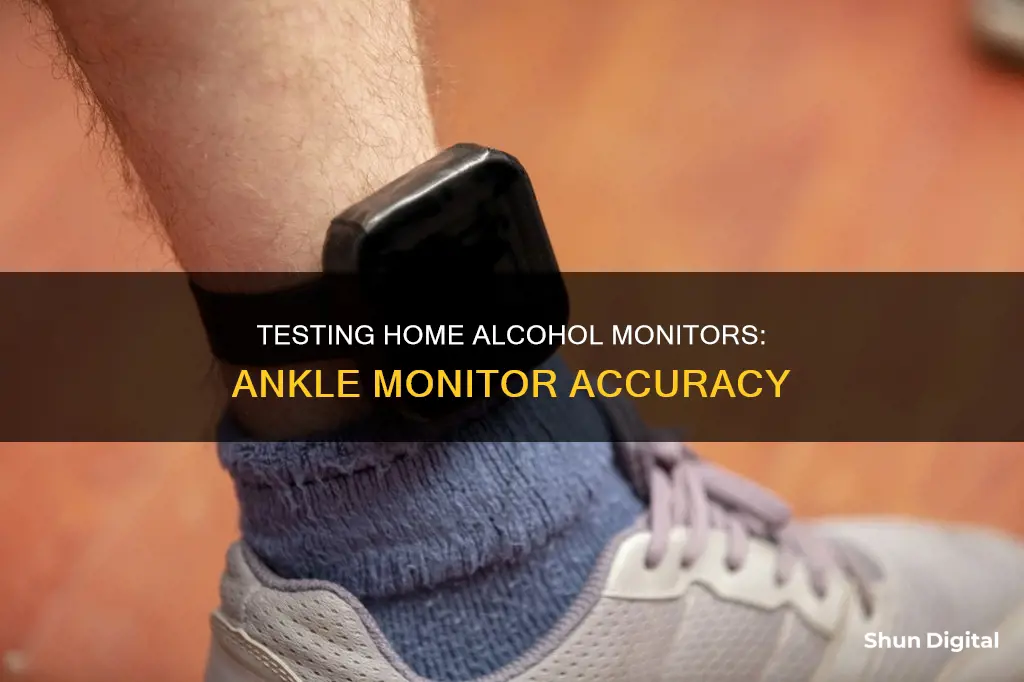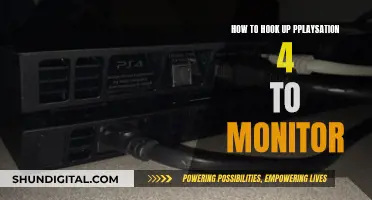
A SCRAM ankle monitor is an alcohol detector in the form of an ankle bracelet. The bracelet tests the wearer's perspiration for alcohol every thirty minutes to thirty seconds, twenty-four hours a day. This skin-level measurement is known as transdermal alcohol concentration. The device then uploads the results via the internet to a third-party company that monitors it. If the SCRAM reports any alcohol in the wearer's system, analysts will review the data and report back to the courts and the wearer's probation officer.
| Characteristics | Values |
|---|---|
| Name | SCRAM (Secure Continuous Remote Alcohol Monitor) |
| Form | Ankle bracelet |
| Purpose | Monitor blood alcohol concentration |
| Use | Court-ordered for DUI offenders, or as a pretrial condition of probation |
| Testing | Tests wearer's perspiration every 30 minutes |
| Alert System | Sends alerts to a database, which are then reviewed by trained analysts |
| Installation Fee | $50 to $100 |
| Daily Monitoring Fee | $10 to $15 |
| Monthly Cost | Up to $300 to 450 |
| Removal | Only allowed after the court-ordered sobriety period is over |
| Duration | 30, 60, 90 days, or longer |
| Detection Sensitivity | Detects blood alcohol content (BAC) of less than 0.02% |
| Tamper Proof | Equipped with industry-leading anti-tamper technology |
What You'll Learn

How does it work?
The SCRAM CAM® (Secure Continuous Remote Alcohol Monitor) bracelet is an innovative way to carry out continuous alcohol monitoring. The bracelet is fitted to the ankle of an individual and is typically worn for 30, 60, or 90 days. It is designed to work 24 hours a day and continuously detects alcohol coming from the user.
The SCRAM bracelet tests the wearer's perspiration or sweat every 30 minutes to 30 seconds for the presence of alcohol. This skin-level measurement is known as "transdermal" alcohol concentration. It will conduct tests when the wearer is sleeping, at work, out with friends, or not profusely sweating. When a person drinks alcohol, a certain amount will be metabolized and emitted as sweat through skin pores. The SCRAM device detects the presence of alcohol at the surface of a person's skin in the area where the device is located (the ankle).
The SCRAM bracelet then transmits the test results to a regional monitoring centre or a base station. If the participant is not in range of the base station, the bracelet will still gather information and transmit readings when the participant is back in range. The readings are then uploaded via modem and monitored by a private company. If the defendant tests positive for alcohol, the company reports it to the court.
The SCRAM bracelet is equipped with temperature and infrared sensors that can detect attempts at tampering or obstruction. If the SCRAM bracelet is tampered with, the company monitoring the device will receive a notification and report it to the court or the probation department.
Best Monitor Brands: Your Ultimate Buying Guide
You may want to see also

How long do you have to wear it?
The length of time someone has to wear an alcohol ankle monitor depends on the nature of their conviction. If the offender is wearing the bracelet as a pretrial condition of being released from jail, their movements may be restricted by the parameters of their release.
In criminal cases, the court orders the defendant to wear the bracelet for a set period of time, often 60 or 90 days. However, in some cases, the offender must wear a SCRAM monitor for a year or longer as a term of probation or parole. You will not have to wear the SCRAM monitor forever, but it could be a month to a year or even longer than a year.
Studies have shown that wearing a SCRAM bracelet for at least 90 days, when coupled with alcohol treatment, can reduce the risk that a person convicted of driving under the influence will re-offend.
Hooking Up a TFT Monitor: A Step-by-Step Guide
You may want to see also

Can you trick it?
The SCRAM CAM bracelet is a highly secure device with industry-leading anti-tamper technology. It is extremely difficult to trick or outsmart. The device is equipped with a fibre optic cable that runs through the strap and connects to the 'box' on both sides. If the fibre optic cable connection is interrupted in any way, it will trigger an alert.
Some common ways people try to trick the device include:
- Obstructing the skin censor so it cannot read the transdermal alcohol consumption
- Pouring alcohol directly on top of the device to mask alcohol consumption
- Getting the bracelet wet to try and break it
- Physically breaking the bracelet with a hammer
However, these attempts are futile and will either not work or will result in the service provider being notified, which means the wearer's probation officer will be notified. This could lead to stricter punishments, such as a longer probation period.
The only way to remove the device without triggering an alert is to cut off the wearer's foot, but this is obviously not a viable option. While no security system is completely invulnerable, it would require significant financial resources and technical knowledge to even attempt to breach the SCRAM CAM's security.
Best Monitor Size for Call of Duty Experience
You may want to see also

How much does it cost?
The cost of a home-based alcohol ankle monitor varies depending on several factors, including location, income, and specific device features. Here is a detailed breakdown of the costs associated with these monitoring systems:
Initial Setup or Installation Fee:
The initial setup or installation fee for a home-based alcohol ankle monitor typically ranges from $50 to $200. This is a one-time fee that covers the cost of getting the device set up and installed on the wearer.
Daily or Monthly Monitoring Fees:
Daily monitoring fees for alcohol ankle monitors usually fall between $5 and $20 per day. This amounts to approximately $150 to $600 per month, depending on the specific fee within that range. These fees are charged for the ongoing monitoring service provided by the device.
Device Cost to the Government:
The cost of the ankle monitor device itself to the government is estimated to be between $800 and $1,500 per device. This cost covers the technology, equipment, and materials used in the monitors.
Additional Costs:
There may be additional costs associated with the ankle monitor, such as fees for violations, maintenance, or service calls. These extra costs can vary depending on the specific circumstances and the company providing the monitoring service.
Cost Comparison with Other Options:
It is worth noting that house arrest or ankle monitoring is generally considered more affordable than prison or jail time. According to FindLaw.com, the average cost of house arrest is $6,000 per year, compared to $20,000 per year to house a prisoner.
Personal Use Ankle Monitors:
Ankle monitors for personal use, which may include those used for fitness or health tracking, typically cost between $150 and $250, depending on the brand and the retailer. These monitors may not have all the features of the ones used for criminal justice or court-ordered monitoring.
Cost Considerations:
When considering the cost of a home-based alcohol ankle monitor, it is important to take into account the specific circumstances, location, and income of the individual. Some states or counties may offer sliding scale rates based on income, which can make the monitoring more affordable for those with lower incomes. Additionally, the specific features and capabilities of the device can also impact the overall cost.
Unboxing Your ASUS Monitor: A Step-by-Step Guide
You may want to see also

What happens if you try to remove it?
SCRAM (Secure Continuous Remote Alcohol Monitoring) bracelets are equipped with industry-leading anti-tamper technology that identifies circumvention attempts. If someone tries to remove a SCRAM bracelet, the company that monitors the device will be notified and will report the tampering to the court or the probation department. Removing the bracelet will result in severe consequences for the offender, such as termination of probation, harsher sentencing, longer probation, or jail time.
The SCRAM bracelet is designed to be easy to remove in an emergency. It has a labelled line that tells the wearer where to cut if necessary. However, it is very difficult to take off the bracelet and put it back on later without detection. The bracelet is worn on the ankle, making it challenging to remove intact. Parole officers or supervisors regularly inspect the bracelets for any signs of tampering, such as cut marks or twisted plastic. If they find any evidence of tampering, the offender is considered to have violated the terms of the monitoring program.
The radio transmitter embedded in the bracelet is programmed to send a distress signal as soon as it is tampered with. This is achieved through a wire that runs the length of the band, which, when cut, breaks a circuit and sends an alert to the authorities. Some bracelets also use internal light sensors to detect if the transmitter's housing has been pried open.
In summary, attempting to remove a SCRAM bracelet will result in immediate detection and severe consequences, including possible jail time. The bracelet is designed to be easy to remove in an emergency but challenging to take off without leaving signs of tampering. Parole officers and supervisors regularly inspect the bracelets for any signs of interference, and if found, it will be considered a violation of the monitoring program.
Connecting a Monitor to a TV: Easy Steps to Success
You may want to see also
Frequently asked questions
A home-based alcohol ankle monitor, also known as a SCRAM (Secure Continuous Remote Alcohol Monitor) bracelet, is an innovative way to carry out continuous alcohol monitoring. The bracelet is fitted to the individual's ankle and tests their perspiration for alcohol content every 30 minutes. The device then uploads the results via the internet, where third-party companies can monitor them.
Home-based alcohol ankle monitors are typically accurate, but there are times when they give false readings. There are more issues with false negatives than false positives, so you don't have to worry about getting into trouble for consuming alcohol when you haven't been drinking. However, products that contain alcohol, like perfume, lotions, mouthwash, and hand sanitizer, could potentially set off the monitor.
If you try to remove a home-based alcohol ankle monitor, the regional monitoring center will be alerted immediately, and you will face consequences such as termination of probation, jail time, or longer probation.







